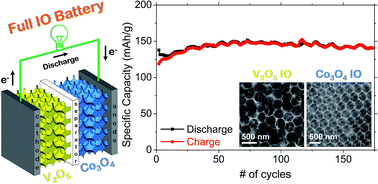High performance inverse opal Li-ion battery with paired intercalation and conversion mode electrodes†
Abstract
Structured porous materials have provided several breakthroughs that have facilitated high rate capability, better capacity retention and material stability in Li-ion batteries. However, most advances have been limited to half cells or lithium batteries, and with a single mode of charge storage (intercalation, conversion, or alloying etc.). The use of dual-mode charge storage with non-traditional material pairings, while maintaining the numerous benefits of nanoscale materials, could significantly improve the capacity, energy density, stability and overall battery safety considerably. Here, we demonstrate an efficient, high capacity full inverse opal Li-ion battery with excellent cycle life, where both the cathode and anode binder-free electrodes are composed of 3D nanocrystal assemblies as inverse opal (IO) structures of intercalation-mode V2O5 IO cathodes and conversion-mode Co3O4 IO anodes. Electrochemically charged Co3O4 IOs function as Li-ion anodes and the full V2O5/Co3O4 cell exhibits superior performance compared to lithium batteries or half cells of either IO material, with voltage window compatibility for high capacity and energy density. Through asymmetric charge–discharge tests, the V2O5 IO/Co3O4 IO full Li-ion cell can be quickly charged, and discharged both quickly and slowly without any capacity decay. We demonstrate that issues due to the decomposition of the electrolyte with increased cycling can be overcome by complete electrolyte infiltration to remove capacity fading from long term cycling at high capacity and rate. Lastly, we show that the V2O5 IO/Co3O4 IO full Li-ion cells cycled in 2 and 3-electrode flooded cells maintain 150 mA h g−1 and remarkably, show no capacity fade at any stage during cycling for at least 175 cycles. The realization of an all-3D structured anode and cathode geometry with new mutually co-operative dual-mode charge storage mechanisms and efficient electrolyte penetration to the nanocrystalline network of material provides a testbed for advancing high rate, high capacity, stable Li-ion batteries using a wide range of materials pairings.


 Please wait while we load your content...
Please wait while we load your content...